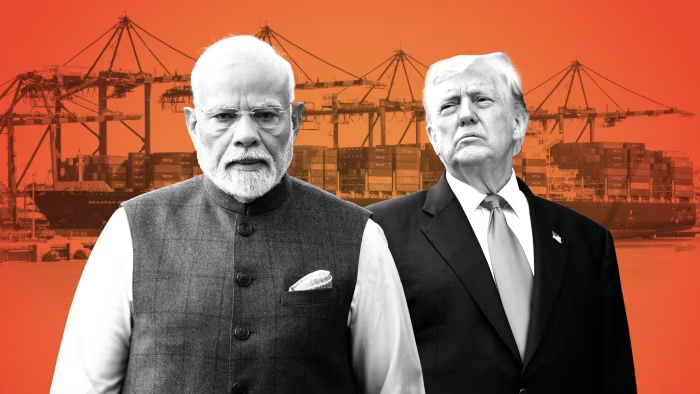Over the past few months, a new chapter in U.S.–India relations has emerged—one marked by rising protectionism, strategic misreadings, and a political will on both sides to stand firm. With the United States under Donald Trump imposing a 50% tariff on key Indian exports, the economic and diplomatic temperature has risen sharply. What began as a dispute over trade imbalances has evolved into a broader standoff involving sovereignty, strategic influence, and political optics.
This blog breaks down why Trump is pressuring India, the real reasons behind this tariff war, the potential positive and negative impacts on both nations, how India is attempting to shield itself, and what lessons can be drawn from similar disputes Trump is stoking with other countries.
A Global Pattern: Trump’s Aggressive Tariff Diplomacy
Trump’s current trade posture toward India isn’t happening in isolation. Across the globe, the administration has sought to pressure key economies with steep tariffs—be it China, the EU, or Canada—on the grounds of “protecting American jobs” and “rebalancing unfair trade practices.”
However, these moves often carry hidden political objectives:
- Domestic Election Optics – Tariffs are marketed to American voters as decisive action against “unfair foreign advantage,” even when the targeted sectors are not the root cause of U.S. job losses.
- Strategic Signaling – By targeting large economies like India, Trump demonstrates willingness to confront any nation that challenges U.S. trade preferences.
- Negotiating Leverage – In several cases, steep tariffs have been used as an opening gambit to extract concessions in unrelated areas such as defense deals or foreign policy alignment.
For India, the 50% tariff has been framed by the U.S. as a corrective measure for “imbalanced” trade, but in reality, it is deeply intertwined with Washington’s dissatisfaction over New Delhi’s purchase of discounted Russian oil and its reluctance to toe the American line on certain geopolitical issues. (Al Jazeera)
Why Trump is Targeting India
1. Energy Trade with Russia
India has become one of the largest buyers of Russian crude since sanctions were placed on Moscow. This oil, often processed and re-exported, indirectly enters global markets—including the United States. From Washington’s perspective, this undermines its sanctions regime. Yet India has consistently defended its purchases as a matter of energy security and economic pragmatism.
2. Trade Deficit Politics
Though the actual trade deficit with India is modest compared to China, Trump’s economic narrative often lumps all deficits together as evidence of “bad deals.” By targeting India’s export-driven sectors (especially in agriculture and textiles), the administration aims to reduce the flow of goods into the U.S.
3. Signaling to Other Allies
Punishing India sends a message to other countries considering economic cooperation with Russia or resisting U.S. policy demands. It reinforces the idea that Washington is willing to impose economic costs on even its strategic partners.
India’s Response: Standing Firm
Rather than immediately seeking compromise, India’s response has been measured but resolute.
The Ministry of External Affairs labeled the tariffs “unfair, unjustified and unreasonable,” pointing out that other major importers of Russian oil had not been penalized. This selective targeting, New Delhi argues, undermines the moral and legal credibility of the U.S. position.
Prime Minister Narendra Modi’s stance has been especially striking. In a public address, he declared:
“India will never compromise on the interests of its farmers, livestock rearers, and fisherfolk. And I know that I will personally have to pay a very heavy price for this, but I am ready.” (The Guardian)
This was not merely rhetorical flourish—it reflected a conscious choice to prioritize domestic economic stability and political credibility over short-term trade relief. Modi’s words also underscored how agriculture, fisheries, and rural livelihoods form the political backbone of India’s democracy.
The Logic Behind India’s Tariff Playbook
According to CNBC’s analysis, India’s trade strategy operates on three pillars:
- Diversification of Markets – India has steadily expanded trade with the Middle East, Africa, and Southeast Asia, reducing dependence on the U.S. market.
- Domestic Manufacturing Push – Initiatives like “Make in India” and production-linked incentives aim to boost local output, making the economy more self-reliant in the face of external shocks.
- Retaliatory Capacity – India has signaled willingness to impose counter-tariffs on U.S. goods if negotiations fail, though it prefers a diplomatic resolution.
Trump may be misreading India’s resolve—assuming that the loss of U.S. market access would quickly bring New Delhi to the table. In reality, India has been preparing for exactly this scenario.
Potential Impacts on Both Countries
For the United States
Negative:
- Higher prices for U.S. importers and consumers on Indian goods like textiles, spices, and auto parts.
- Strained diplomatic relations with a key partner in countering China’s rise.
- Risk of retaliatory tariffs that could hurt American agricultural and tech exports.
Potential Positive:
- Political gains for Trump among domestic manufacturing and farming constituencies who perceive foreign competition as a threat.
- A short-term boost to select U.S. producers who compete with Indian imports.
For India
Negative:
- Reduced export earnings in targeted sectors, leading to job losses in export-oriented industries.
- Potential cooling of U.S. investment flows into India’s tech and service sectors.
- Diplomatic costs in multilateral forums if trade disputes spill over into broader cooperation.
Potential Positive:
- Acceleration of market diversification away from over-reliance on U.S. buyers.
- Strengthening of domestic supply chains under government support programs.
- National political unity around defending sovereignty against perceived external coercion.
Impact on Citizens
For American consumers, the most direct effect will be price hikes on imported Indian goods. Import-dependent businesses may pass on costs, while smaller retailers could reduce product variety.
For Indian citizens, especially in manufacturing and agriculture, the impact will be sector-specific. Workers in export-driven industries could see reduced orders and layoffs. However, government subsidies and alternative market arrangements may cushion the blow.
Lessons from the Indian Express Analysis
The Indian Express highlights an important dimension: Trump’s use of tariffs as a “pressure tactic” rather than a final economic measure. Past experiences with other countries show that such tariffs are often rolled back or reduced when concessions are made in unrelated policy areas.
India’s lesson here is clear: holding ground can sometimes lead to better terms, but it also requires economic resilience and political endurance.
The Bigger Picture: Beyond Bilateral Tensions
Trump’s tariff war with India must be viewed within the larger tapestry of global trade disruptions. Similar conflicts have been unfolding with the EU over agricultural imports, with China over tech and industrial subsidies, and with Mexico over automotive exports.
The common thread is Trump’s transactional view of trade: everything is negotiable, nothing is sacred, and pressure is a valid form of diplomacy.
For India, this presents both a challenge and an opportunity—a challenge because it disrupts stable market expectations, an opportunity because it strengthens the case for economic self-reliance and diversified alliances.
Conclusion
The U.S.–India tariff war is not merely about trade numbers—it’s about political leverage, strategic alignment, and national image. Trump’s decision to impose 50% tariffs may win him domestic applause, but it risks alienating a crucial partner at a time when U.S. policy in Asia depends on strong alliances.
India’s refusal to yield—articulated most forcefully in Modi’s declaration that he is “ready to pay a heavy price”—signals a new phase in its global economic posture: one that values sovereignty over expediency, resilience over quick concessions.
Whether this standoff ends in compromise or prolonged confrontation will depend on both sides’ willingness to look beyond immediate political gains and toward the long-term value of partnership.




Thank you for the auspicious writeup It in fact was a amusement account it Look advanced to far added agreeable from you However how can we communicate
Your blog is a true hidden gem on the internet. Your thoughtful analysis and engaging writing style set you apart from the crowd. Keep up the excellent work!
I was recommended this website by my cousin I am not sure whether this post is written by him as nobody else know such detailed about my trouble You are amazing Thanks
Your writing is like a breath of fresh air in the often stale world of online content. Your unique perspective and engaging style set you apart from the crowd. Thank you for sharing your talents with us.
I was suggested this web site by my cousin Im not sure whether this post is written by him as no one else know such detailed about my trouble You are incredible Thanks
I’ve been following your blog for some time now, and I’m consistently blown away by the quality of your content. Your ability to tackle complex topics with ease is truly admirable.